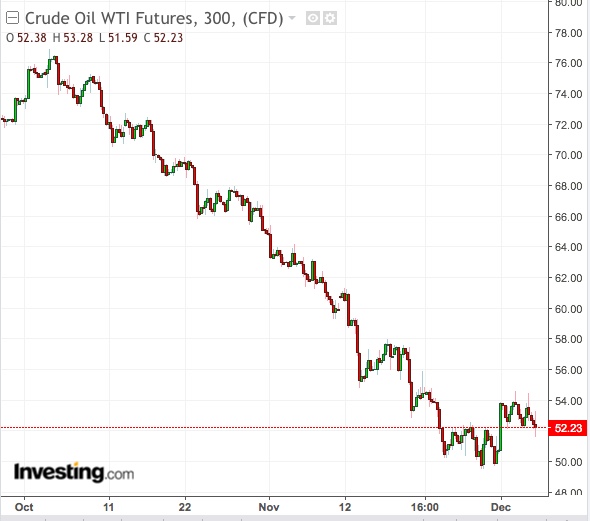The curse of shale is its gift of cheap oil to the world, so much that few remember the spectacular blow-up of US drillers during the crude price crash of two years ago.
Hedge funds, of course, can short sell shale stocks to profit in bad times. Still, this is not a crowded trade as many energy funds seem to have faith in the longevity of the industry and its ability to survive at low prices. How did these funds perform this year?
“Not very good” can be a fitting description for a broad section of the shale-believing fund universe, and “terrible” will be apt to describe some performances in particular. Two funds that capture this range are UK-based Westbeck Energy Opportunity Fund, which is down 7 percent for the year through October, and New York-based Equinox Energy Fund, which has lost 65 percent on the year, according to returns data shared privately by the funds with their investors and seen by Investing.com.
The performances are an important study amid Thursday's meeting of the Organization of the Petroleum Exporting Countries, which is again facing an oversupply crisis partly due to the US shale drillers and the notion that they can survive any low in crude prices.
Shale Production Fears Overblown
The Westbeck fund, led by former Goldman Sachs money manager and Lehman Brothers oil trader Jean-Louis Le Mee, detailed the many misconceptions about the seeming invincibility of US oil drillers in a near 30-page letter to its investors in October, with bullet-points that included: “Shale runaway production growth fears are overblown.”
The fund’s remarks came as leading shale drillers said plunging oil prices could force them to pull back on production, after a flood of crude unleashed this year. Harold Hamm, chief executive of Continental Resources, which helped pioneer horizontal drilling and fracking in the Bakken Shale region 15 years ago, told The Wall Street Journal in a recent interview that the company could operate at even below $40 a barrel, but “we’re not here to sell our reserves at a marginal cost.”
Westbeck’ portfolio includes global upstream oil explorers such as Parex Resources (TO:PXT), Premier Oil (LON:PMO), Tullow Oil (LON:TLW), Gran Tierra Energy (NYSE:GTE), Aker BP (OL:AKERBP) and Enquest (LON:ENQ).
Painful Differential Pricing

Acknowledging its “very costly” mistake to increase risk in October as crude prices fell 10 percent on the month—November was an even bigger catastrophe for oil bulls with a 22 percent plunge—Westbeck said a “painful differential pricing” was now spreading across shale.
Breaking the differentials down, Westbeck said oil from the Bakken basin was trading at some $15 discount to the US benchmark, West Texas Intermediate (WTI). Shale crude from the Midland basin in Texas fetched $7 per barrel to WTI. The worst was Canadian crude, which traded as much as $35 less to the US benchmark.
Westbeck added that production cuts of 150,000 barrels per day mulled by Canadian crude producers as of October “may not be the last”. Indeed, Canada’s Alberta region announced this week plans to cut 325,000 barrels per day, or nearly 9% of its output, beginning January to try and reverse a historic price slide in its oil versus WTI.
Capex Cutbacks In Drilling Coming
Westback said:
“It is likely the current oil price pullback, at a time when 2019 budgets are being discussed, will put another dent in the limited capital expenditure recovery that was only starting to emerge. The wave of consolidation we are currently experiencing in the US together with the strong capital discipline message expressed by all the majors and large independents on Q3 earnings calls confirm plans are to remain cautious on spending.”
Westback added that production data skewed to the major shale producing areas also tend to give a distorted and “dangerous” picture to the market,
“particularly when the 3 key shale basins (Bakken, Permian and Eagle Ford) ‘only’ grew by 150,000 barrels per day in August.”
It said that while there was no question the total number was large, it was only about 90,000 above expectations put forth by the US Energy Information Administration (EIA).
Westbeck added:
“Importantly, the EIA STEO (Short-Serm Energy Outlook) model is ‘unconstrained’ – and most market participants we talk to seem unaware of this fact: it ignores infrastructure/pipeline limitations.”
Two major pipelines carrying oil from Canada to the United States experienced brief disruptions this week due to power outages from severe weather in Saskatchewan, Canada, a day earlier.
Market Is Too Complacent With Shale
Westbeck said it expected the alarming lack of investments in shale will start to haunt the oil markets in 2019 and will become a massive supply headwind in 2020-2022. It said:
“The markets are too reliant on shale and too confident it can make up for the unprecedented dearth of long cycle investments. M&A and well data are both starting to confirm that the markets should worry about the ability of shale to maintain high (and increasing?) growth rate year in/year out. We think the market is probably too complacent, and we think its complacency will be tested over the next two or three years.”
Equinox Energy, which describes itself as a concentrated portfolio of undervalued energy companies, did not issue an investor letter on its losses.
But its performance breakdown showed October to be the worst month since its inception in 2015, with a loss of 35 percent. The year-through-October loss of 65 percent is also its largest annual loss in those three years.
With October’s decline, the firm said assets under management just at the Equinox Energy Fund was at $9 million, while firm-wide AUM stood at $495 million. It’s unclear what those numbers are now.
